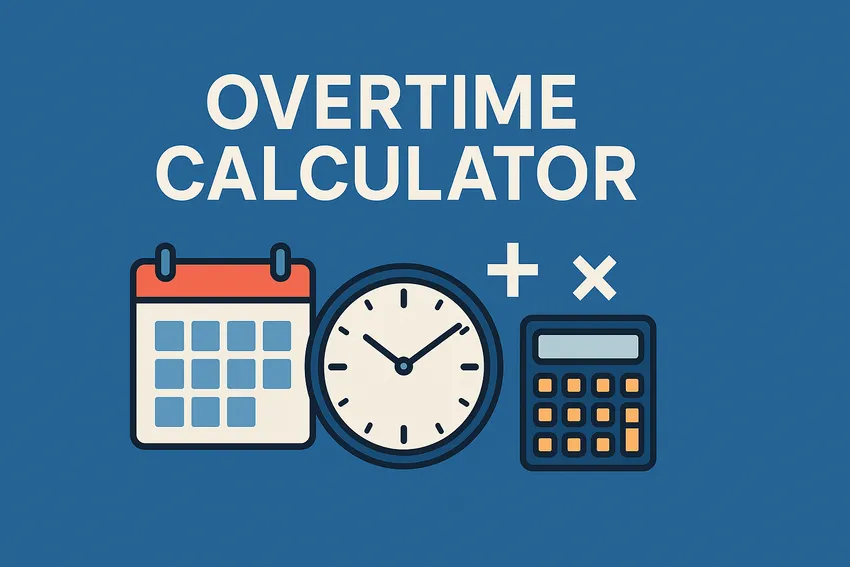- Overtime Kicks In After 40 Hours: In the U.S., non-exempt employees must be paid overtime (at least “time and a half” their regular rate) for any hours worked beyond 40 in a workweek.
- “Time and a Half” = 1.5× Pay Rate: Time-and-a-half means 150% of the normal hourly wage. For each overtime hour, the worker earns their full regular rate plus an extra half of that rate.
- Some Workers Are Exempt: Not all jobs qualify for overtime. Exempt employees (e.g. certain salaried managers, professionals, etc.) aren’t legally required to get overtime pay if they meet specific criteria.
Overtime Calculator: What Is Overtime Pay?
Overtime pay is the extra compensation owed to employees who work beyond a standard workweek limit (typically 40 hours per week in the U.S.).
Under the federal Fair Labor Standards Act (FLSA), covered non-exempt employees must receive overtime pay at a rate of at least “time and one-half” (1.5×) their regular pay for all hours over 40 in a workweek.
This means if you work more than 40 hours, your employer must pay 50% more per hour for those extra hours. Importantly, there’s no maximum—workers aged 16 and older can work any number of hours, as long as overtime pay is provided for overtime hours.
Overtime is calculated weekly. Each workweek stands alone: you cannot average hours over two weeks.
For example, working 50 hours one week and 30 the next doesn’t avoid overtime; the 10 hours over 40 in the first week still count for overtime.
Also, federal law does not require special overtime pay just for working on weekends or holidays unless those hours exceed 40 for the week.
What Does “Time and a Half” Mean?
“Time and a half” is simply a way to describe the overtime premium rate. It means an employee earns 1.5 times their normal hourly rate for each overtime hour. In practical terms, time-and-a-half is 50% more pay per hour than the regular rate.
For example, if your standard wage is $20 per hour, your time-and-a-half overtime rate is $30 per hour ($20 × 1.5).
The FLSA mandates time-and-a-half as the minimum overtime pay nationwide, though some states impose even higher rates for certain hours (like “double time,” which is 2× pay, in specific situations – more on that shortly).
Time-and-a-half pay is essentially your regular pay plus an additional half of your rate for each overtime hour. This extra half-rate is the overtime premium. The concept ensures that employees are fairly compensated for long work hours, disincentivizing employers from overworking staff without extra pay.
How to Calculate Overtime Pay
Calculating overtime pay is straightforward with the right formula (or by using an overtime calculator tool). Below are the key formulas and an example to illustrate them:
- Overtime Hourly Rate Formula: Regular hourly rate × 1.5. This gives the “time-and-a-half” rate per overtime hour. For instance, if someone’s regular pay is $20/hour, their overtime rate is $20 × 1.5 = $30/hour.
- Overtime Pay Formula: Overtime hourly rate × number of overtime hours worked. This calculates the extra overtime compensation due for the overtime hours. Using the above example, if 5 overtime hours were worked, overtime pay = $30 × 5 = $150.
- Total Weekly Pay with Overtime: (Regular pay for first 40 hours) + (Overtime pay for hours > 40). In formula form, that’s: (Hourly Rate × 40) + (Overtime Rate × Overtime Hours). This yields the gross pay including overtime. For example, at $20/hour with 45 hours worked, regular pay = $20×40 = $800, overtime pay = $30×5 = $150, so total pay = $950.
Example Calculation: Suppose an employee earns $12 per hour and works 45 hours in one week. Their overtime would be 5 hours beyond 40.
First, find the overtime rate: $12 × 1.5 = $18 per hour. Then calculate overtime pay: $18 × 5 hours = $90 in overtime earnings.
The regular 40 hours amount to $12 × 40 = $480. Add the overtime pay on top of regular pay: $480 + $90 = $570 total gross wages for the week.
This matches what an overtime calculator would show and ensures the worker gets proper time-and-a-half compensation.
If you have a salaried non-exempt employee (i.e. they are eligible for overtime), the calculation involves finding their equivalent hourly rate.
For example, a $1,200 weekly salary intended for 40 hours equates to $1,200/40 = $30/hour.
Overtime is then paid on top of that: overtime rate $30 × 1.5 = $45. If that salaried employee worked 42 hours in a week, they’d earn $1,200 for the first 40 hours plus $45 × 2 = $90 for the 2 overtime hours, totaling $1,290.
In short, being salaried does not automatically exclude someone from overtime – you just have to compute their pay rate and then apply the overtime formula.
Many online overtime calculator tools or payroll software can do these calculations for you automatically. Whether you calculate by hand or use a calculator, the key is ensuring that every hour over 40 is paid at 1.5× the regular rate (or higher if state law applies). This guarantees employees receive the full overtime premium they’re entitled to.
U.S. Overtime Pay Rules and Regulations
Federal law (FLSA) sets the baseline: overtime pay is required for hours beyond 40 in a week at no less than 1.5× the regular rate. The “regular rate” includes the employee’s base pay and most bonuses/commissions, averaged to an hourly rate.
There’s no federal requirement for overtime pay on daily hours (e.g. working over 8 hours in a day) – it’s all about the weekly total.
Also, working nights, weekends, or holidays doesn’t automatically trigger overtime under federal law unless those hours push the weekly total over 40. Employers can schedule long shifts or 7-day weeks, but must pay overtime for the excess hours.
State laws can add more protections. Some states have stricter overtime rules than federal law.
For example, California requires time-and-a-half pay not only after 40 hours per week but also after 8 hours in a single day. California even mandates double-time pay (2× the normal rate) for hours beyond 12 in a day or beyond 8 on the seventh consecutive day of work.
California is one of the only states with a double-time requirement. Always check your state’s overtime laws, as they may impose daily overtime, different weekly thresholds, or other conditions.
In any case, employers must follow whichever law (state or federal) is most beneficial to the employee.
Overtime Pay Exemptions in the U.S.
Certain employees are exempt from overtime pay requirements, meaning their employers are not obligated to pay them overtime (time-and-a-half) when they work over 40 hours. These exemptions are defined by the FLSA and generally apply to categories of jobs with specific duties and salary criteria.
Exempt employees typically include those in bona fide executive, administrative, professional, outside sales, or certain high-level computer positions.
To qualify as exempt, an employee usually must: (1) be paid a salary (not hourly), (2) earn at least a minimum specified amount, and (3) perform job duties that are considered exempt in nature (i.e. higher-level responsibilities). All three conditions are required for the exemption.
Under current federal rules, the salary threshold for overtime exemption is $684 per week (equivalent to $35,568 per year). Employees paid less than this amount cannot be classified as exempt, regardless of their job title – they must receive overtime pay if they work over 40 hours.
Employees above this salary level may be exempt only if their primary job duties are executive, administrative, professional, etc., as defined by law. For example, managers who supervise others and have decision-making authority, or professionals like doctors, lawyers, and engineers (who meet the earning test), are often exempt.
Outside salespeople who work away from the office are another exempt category, as are certain computer software roles. Highly compensated employees (earning over $107,000/year) can also be exempt if they perform at least one exempt duty.
It’s important to note that being salaried alone isn’t enough to be exempt. There’s a common misconception that any salaried employee doesn’t get overtime – in reality, if a salaried worker’s pay is below the threshold or their role doesn’t meet the duty tests, they are non-exempt and must be paid overtime if they work over 40 hours.
Many lower-salary managers or administrators, for instance, still qualify for overtime because they don’t meet all exemption criteria. Misclassifying employees as exempt when they should be getting overtime can lead to legal trouble and owed back pay.
Aside from the white-collar exemptions, the FLSA also has specific exemptions for certain industries and job types (e.g. some farm workers, certain transportation employees, independent contractors, etc.), but the majority of workers fall under overtime protection.
Always double-check if a particular position is truly exempt. When in doubt, assume an employee is non-exempt so they receive due overtime pay – the law errs on the side of protecting workers’ pay.












Loading comments...